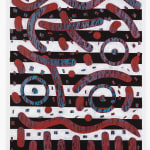-
Julia Dault
Jail Break, 2020Acrylic and oil on canvas36 x 24 inches*work may be oriented horizontally or verticallyWithin Julia Dault's abstract paintings, there are certain constants alongside her wide range of color, material application, and pattern. One of these is a technique known as sgraffito, which involves...Within Julia Dault's abstract paintings, there are certain constants alongside her wide range of color, material application, and pattern. One of these is a technique known as sgraffito, which involves applying layers of paint to a surface and then removing the topmost layer to reveal the underlying color and composition. Dault develops her layers with both paint and commercially bought textile, and employs industrial tools like combs, rakes, and squeegees, for the removal process. Another constant is Dault's propensity to depict visual complexity and variety, even amidst sets of formal rules and guidelines, which the artist self-imposes. Recalling tenets of minimalism and conceptual art, while carving a new path in abstract painting, Dault suggests an undeniable energy and expression surfacing out from systems."Jail Break is a pivotal painting. At first I was paralyzed when COVID hit and it felt as if the world had turned upside-down. But then something happened in the studio: I experienced this shift in making that channeled all of my angst into feeling like I needed to make the best work I could possibly make; the determination to press on -- or through -- was really powerful; I allude to this in the title of the painting. Speaking of upside-down, I've also been playing with physical orientation, of late, which is another way of addressing this paradigmatic shift we're living through; some recent paintings are orientation-less and can be shown either upright or 'upside-down', including Jail Break. The painting is signed twice to make this clear (on the 'top' and 'bottom'). I love the idea that a work can have a different orientation throughout its existence and, as someone who appreciates visual variety, I like the fact that when it is turned, it can be seen anew."- Julia Dault



